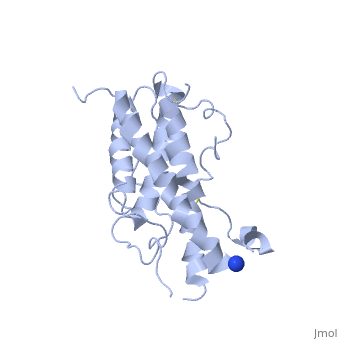Sandbox Reserved 1404
From Proteopedia
(Difference between revisions)
| Line 13: | Line 13: | ||
== Function == | == Function == | ||
| - | Plays an important role in growth control. | + | Plays an important role in growth control. Produced by the pituitary gland, spurring growth in children and adolescents. HGH is also used to regulate body fluids, muscle and bone growth, metabolism, body composition, and possibly heart function. |
| - | Mutations in, or deletions of, lead to growth hormone deficiency and short stature. | + | Mutations in, or deletions of, lead to growth hormone deficiency and short stature. |
| + | |||
== Significance == | == Significance == | ||
Growth Hormone Deficiency occurs when the pituitary gland doesn't produce enough growth hormone. It more commonly affects children than adults. It is symptomatic of other genetic disorders. | Growth Hormone Deficiency occurs when the pituitary gland doesn't produce enough growth hormone. It more commonly affects children than adults. It is symptomatic of other genetic disorders. | ||
Growth hormone travels through the blood and stimulates the liver to produce a protein called <scene name='77/777724/Igf-1/1'>IGF-1</scene>, which helps the cartilage cells located at the ends of long bones to multiply. In children, this leads to growth in the length of the bones and increases the child's height. IGF-1 also acts on immature muscle cells to increase muscle mass. Aside from these growth stimulating functions, growth hormone participates in regulating the body's metabolism. It acts on fat cells to reduce the amount of stored fats, promotes protein synthesis in cells and plays a role in regulating the sugar levels in the blood. Thus growth hormone has multiple effects on the overall form and function of a growing body. | Growth hormone travels through the blood and stimulates the liver to produce a protein called <scene name='77/777724/Igf-1/1'>IGF-1</scene>, which helps the cartilage cells located at the ends of long bones to multiply. In children, this leads to growth in the length of the bones and increases the child's height. IGF-1 also acts on immature muscle cells to increase muscle mass. Aside from these growth stimulating functions, growth hormone participates in regulating the body's metabolism. It acts on fat cells to reduce the amount of stored fats, promotes protein synthesis in cells and plays a role in regulating the sugar levels in the blood. Thus growth hormone has multiple effects on the overall form and function of a growing body. | ||
| + | HGH is also the active ingredient in many prescription drugs and other products available over the Internet. | ||
== Structural highlights == | == Structural highlights == | ||
Revision as of 20:18, 26 February 2018
| This Sandbox is Reserved from January through July 31, 2018 for use in the course HLSC322: Principles of Genetics and Genomics taught by Genevieve Houston-Ludlam at the University of Maryland, College Park, USA. This reservation includes Sandbox Reserved 1311 through Sandbox Reserved 1430. |
To get started:
More help: Help:Editing |
Human Growth Hormone (1HGH)
| |||||||||||
References
https://www.healthline.com/health/growth-hormone-deficiency http://pdb101.rcsb.org/motm/52

